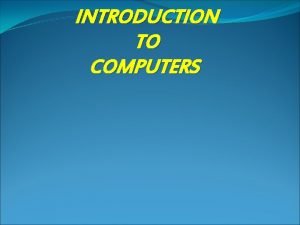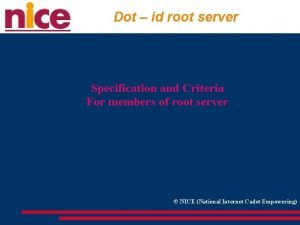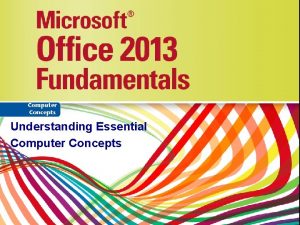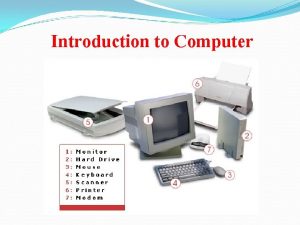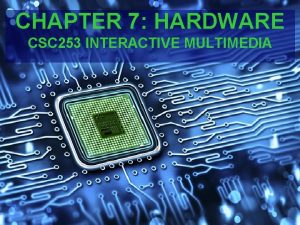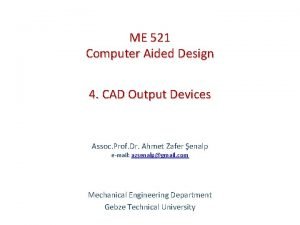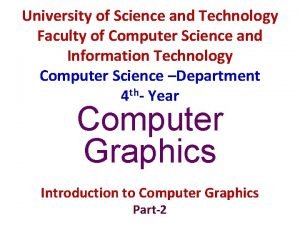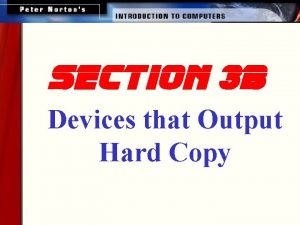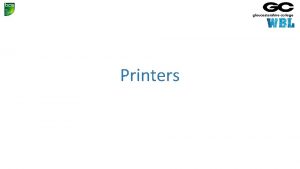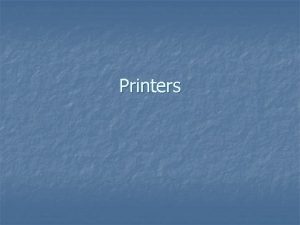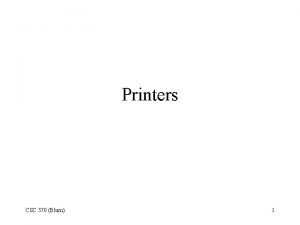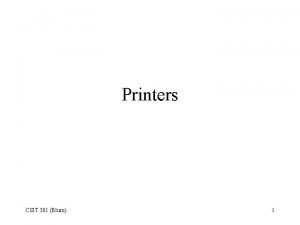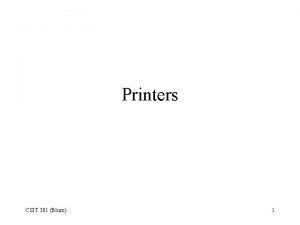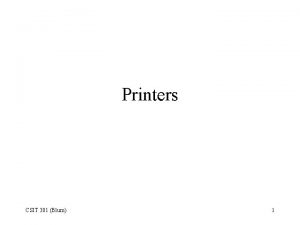Module 7 Printers Printer types Printer Description Dot










- Slides: 10

Module 7 Printers

Printer types Printer Description Dot matrix A dot matrix printer is an impact printer that transfers characters by striking a pattern (from a matrix) through an inked ribbon. The overall print quality of a dot matrix printer is quite poor when compared to that of other types of printers. Ink jet (ink dispersion) Ink jet printers are quiet non-impact printers with ink stored in a reservoir. Bubble jet printers are the most popular form. The ink reservoir is in a disposable cartridge that includes the printing mechanism. • Bubble jet printers print by heating the ink and squirting it through tiny nozzles in the print head and onto the paper. • The crispness of an ink jet printer's image is usually rated in terms of Dots Per Inch or DPI. Ink jets range from 150 to over 1400 dpi. • A new generation of ink jet printers produce photo-quality printouts when used with photoquality paper. Laser printers use lasers and electrical charges to transfer images. Laser printers are classified as page printers because they print text and graphics simultaneously one complete page at a time. • Laser printers use a laser to charge a metal drum. The drum picks up plastic toner, and the toner is then fused on to the paper (using rollers and heat). • Of all the types of printers discussed in this course, laser printers have the highest print quality.

Printer Connections Connection Type Parallel USB, IEEE 1394 Infrared/Wireless Network Description Parallel printers used to be the standard method of connecting printers to a computer. A cable with a 25 -pin DB male connector on one end a Centronics-36 connector on the other end is used to connect the cable to the printer. Parallel printers are increasingly rare today. Many newer printers come with USB or Firewire connectors allowing for configurations that include scanners, external drives, or additional printers. Many printers allow you to connect using a wireless connection that is especially useful with laptop computers. Some printers also have their own network interface card, which allows them to connect directly to a network. Network printers can also be connected to a computer that is connected to the network. Network printers are useful for allowing multiple people to share the same printer. This is a common way to connect printers used in a business environment.

Printer Configuration Term Definition Print device The physical device connected to the print server where print output occurs. Print driver Print queue Printer port The software that allows the printer to communicate with the print device. Printer drivers translate data, manage graphics and allow management of the print job by displaying print and printer properties in the operating system. A virtual device (logical software entity) inside the print server that can be configured to send output to a printing device. The printer is made up of the print driver, the printing device, and the spooler. The portion of the hard drive where print jobs are stored before going to the print device. The means by which a print device connects to a print server. You should look at your printer configuration to see which mode your printer requires.

Printer Configuration To configure a printer, you would: • Connect the print device to an available port. • Create a printer object. For Plug and Play printers connected to a USB port, the printer might be configured automatically. • Edit the printer object to configure device-specific settings such as color profiles, paper trays, or features such as stapling or doublesided printing. • Verify that the printer works by sending a test print. • Ensure that the customer or user knows how to use the printer and any additional features. • If you have more than one printer configured on your computer, the default printer is the printer that will automatically be selected.

Network Printing Consideration Description The printer must have a connection to the network (either wired or wireless). Install a network interface card in the printer. Connect the printer to a workstation or server that is connected to the network. The Connect the printer is shared to make it available to other computers. to the network Connect the printer to a special print server that has a network connection. If the printer itself does not have a network connection, you use the parallel or USB port to connect the printer to another device. The print server manages the flow of documents sent to the printer. An internal print server is inside the printer itself. You use special management software to connect to the print server and manage print jobs. You can configure a server to perform print server functions. The computer can fill Use a print server other roles on the network in addition to being the print server. Most operating systems include print server software. You can purchase an external print server. This device is only used as a print server, although many print servers can manage multiple printers. Each network host that wants to use the printer must have the corresponding printer driver Install the printer installed. When you share a printer in Windows, the current printer driver is automatically drivers delivered to clients that connect to the shared printer.

Troubleshooting Printing It is always best to check the most basic printing functions first before trying to diagnose more technical issues. If a printer does not print, try the following troubleshooting techniques: • Check to make sure that the printer is turned on and is online. • Verify that the cable is connected on both ends and that it is the correct cable for that printer. • Ensure that there is paper in the feed tray and that the tray, feed, and rollers are all in their correct positions. Verify that the correct paper tray was selected when sending the print job. • Look for a paper jam. If a jam is found, clear it and then check any feed and roller mechanisms nearby and confirm that they are clean and operating correctly. • Check the ink and toner levels. • Perform a test print from the printer. – If successful, the problem is with the workstation or the connection. – If unsuccessful, the problem is with the printer itself. • Make sure that the printer is not paused. • Verify that the Print Spooler service is started. • Check the print queue. Sometimes a large document might be first in the queue and is stalled or otherwise preventing other documents from printing. Move the document down in the queue, or if necessary delete the document from the queue.

Troubleshooting Printing It is important to make sure that the following driver issues are addressed when troubleshooting printers: • Verify that the latest version of the driver for the specific make and model of the printer has been installed. If the incorrect driver is installed, this can lead to post-script text, garbled text, and other irregular activity. • Incorrectly configured network printing often leads to end users installing the wrong driver on their machine. Make sure to configure your network so that end users don't have to install the driver on their machine, especially without supervision. • On occasion, driver files may become corrupted. If this is the case, you should reinstall the latest version of the driver from the manufacturer's website.

Troubleshooting Printing If the printer prints, but the printout quality is poor, check the following: • Check ribbon, ink, and toner levels. – For dot matrix printers, printer images become faint when the ribbon needs to be replaced. Most dot matrix print ribbons turn in a continuous loop, causing the ribbon to be used multiple times. Also, ensure that there is not too much gap between the printer head and the paper. – For inkjet printers, if letters have missing lines, use the printer's automatic cleaning feature. If this doesn't work, replace the printer cartridge. For missing or incorrect colors, verify ink levels. If the problem persists, you should download and install the latest printer driver, then use the Properties tab of the printer driver to adjust the driver's color settings. Many times, installing the latest driver alone will fix color issues. If not, then you can manually adjust the color settings until they match the original. – For laser printers with missing lines, try shaking the toner cartridge to distribute the toner evenly. If lines are still missing, or if extra characters appear, you might need to have the printer cleaned or some internal components replaced. • For newer laser and inkjet printers, calibrate the printer (perform a self test). Often the printer uses the self test to check the printed image and make minor adjustments automatically. Calibration fixes blurry text or incorrect colors. • If the text appears garbled, make sure the proper printer driver is used. If necessary, upgrade to the latest version or reinstall the driver. • If the page only prints part way through (and the rest of the page is blank), you might need to upgrade the memory on the printer or check the print server settings. • Check the pickup rollers if paper is not being fed through the printer properly.

Troubleshooting Printing Common mechanical problems that printers have are: • With a parallel printer, ensure that it has a 1284 -compliant cable and the port settings in your BIOS are configured to use the correct 1284 mode. • Too long of a USB cable. Try not to use cables longer than 3 -4 feet; the shorter your cable is, the better your performance is going to be. • Wrong type of paper. – If you're printer isn't feeding paper well, you may want to consider buying higher quality paper. – Because inkjet printers require that ink soaks into the paper, do not use slick, glossy, or wax-coated papers that are not specifically designed for ink-jet printers. – On laser printers, do not attempt to print on paper with photocopied or laser printed images already on it. The images can come off onto parts of the laser printer and smear your print jobs. For other problems, take the printer to a service center so you don't compromise your warranty.
